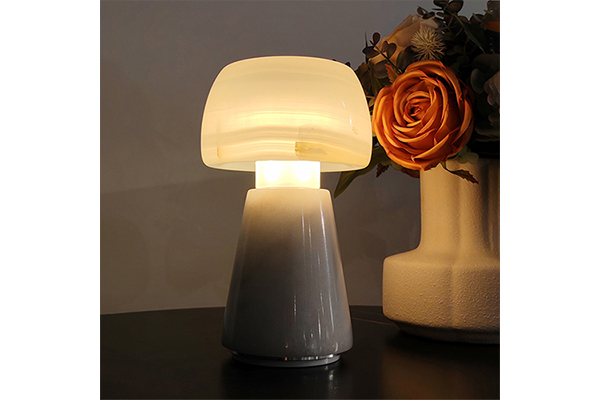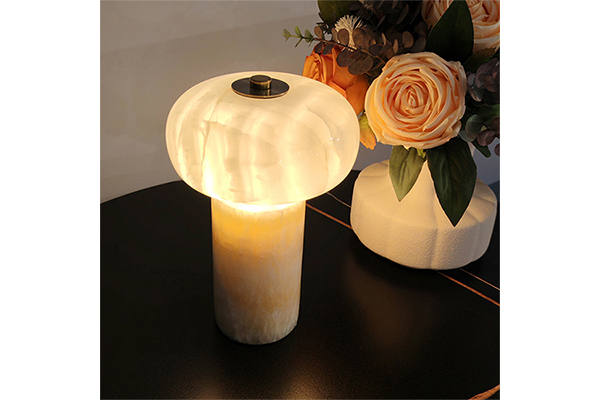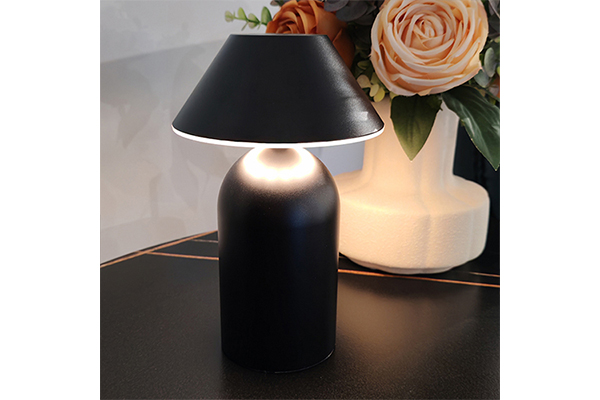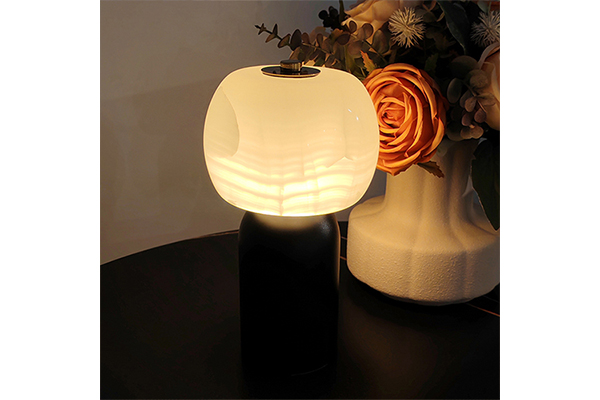How do the pores and textures of natural stone influence the diffused and dappled light from stone lamps?
Release Time : 2025-08-26
In restaurants and hotels striving to create unique ambiances and cultural styles, stone lamps resemble "light sculptures" growing from the depths of the earth, seamlessly blending the timeless textures of rock with the modern art of light and shadow in a strikingly beautiful and innovative way. More than simple lighting fixtures, they become a vehicle for spatial narratives, a tranquil symbol connecting nature, humanity, and the soul, infusing every guest's stay and dining experience with a sense of tranquility, simplicity, and profound poetry.
Their beauty is first and foremost reflected in the "beauty of the earth," derived from natural materials and craftsmanship. Each piece of stone used to craft a stone lamp—whether warm sandstone, rugged granite, delicate marble, or time-worn bluestone—bears unique natural textures, colors, and pores. These natural marks, like the rings of the earth and the veins of a river, are gently awakened by light, presenting a rich and subtle visual layering. When light filters through the cracks, holes, or translucent sheets of stone, it creates a shimmering, dappled landscape, creating a primal atmosphere reminiscent of a cave, a rock face, or moonlit forest. Stone lamps often feature simple yet sculptural forms, with lines ranging from rounded and robust to angular and angular, or mimicking natural forms like mushrooms, pebbles, and mountains. Their sense of volume and weight conveys a sense of calm, reliability, and timelessness. Whether placed alone beside a courtyard water feature or grouped together in indoor corners or at the end of a corridor, they resemble carefully selected works of art, becoming a focal point in any space. Their unique qualities, blending ruggedness with refinement and rustic elegance, instantly elevate the atmosphere and cultural depth of any space. This aesthetic lies not in artificial refinement but in the respect and refinement of natural beauty, in the interplay of light and the texture of the stone, creating an atmosphere of tranquility, Zen, and a return to nature.
The core of their novelty lies in their "symbiosis of nature and humanity" and "unity of function and art." Its novelty lies first in its unique interpretation of light. The light from the stone lamps is not direct and intense; instead, it is diffused, filtered, and softened by the thick or translucent stone, becoming exceptionally soft, warm, and directional. This low-glare light effectively creates an intimate and relaxing atmosphere for dining or relaxing, avoiding the distraction of glare from other sources. Light filters through the stone's natural pores or artificially carved window panes, casting random and artistic patterns of light and shadow, imbuing the space with dynamic movement and surprise. Its novelty is further reflected in the sustainability and uniqueness of the material: stone is a naturally renewable resource (mined responsibly), offering exceptional durability, weathering the elements, and lasting far longer than ordinary lamps. Each stone lamp is unique, as no two pieces share the same texture. This satisfies the pursuit of individuality and rarity in high-end restaurants and hotels.
The lamp's novelty is also reflected in its design diversity and adaptability to various settings. Stone lamps come in a wide variety of forms: they can be floor-standing, like giant stone lamp cages, towering majestically in courtyards or lobbies; they can be wall-mounted, embedded in the wall, appearing to grow from the rock face; they can be compact and delicate, creating a dining tablescape ambiance; and they can even be integrated into water features, half-submerged in water, their reflections swaying, adding a more tranquil atmosphere. Designers can cleverly utilize the light-transmitting properties of stone (for example, by choosing translucent jade slices as lampshades) to create a magical "light within the stone" effect. Modern technology ensures the internal electrical system is safe, concealed, and efficient, while the low-heat, long-life LED light source perfectly complements the durability of stone.
In terms of practical value, the novelty of stone lamps lies in their profound impact on spatial ambiance, brand identity, and guest experience. They transcend the basic function of lighting and become part of the restaurant or hotel's brand story, conveying a commitment to nature, tradition, craftsmanship, and a slow pace of life. They effectively differentiate spaces, guide movement, and create distinct ambiances, ranging from mysterious to warm and solemn, significantly enhancing guests' immersion and creating memorable moments.
In short, stone lamps, with their unique natural stone texture, the dappled effect of light and shadow filtering through the pores, and their sculptural, calm form, evoke the "beauty of the earth" and a "tranquility." They also offer a sense of novelty through softening diffused light to create a comfortable atmosphere, leveraging the uniqueness of stone to create a sense of spatial scarcity, and integrating modern safety technology to ensure long-term use. These lamps have become "light artworks" for high-end spaces. Their beauty lies in the poetic interplay of natural texture and light and shadow; their novelty lies in combining earthly materials with humanistic reflections. With each illumination, they silently tell the story of nature and create a spiritual haven. Although simply a lighting fixture, their timeless materiality and warm glow quietly create a unique experience of retreat from the hustle and bustle and a return to nature within the confines of restaurants and hotels.
Their beauty is first and foremost reflected in the "beauty of the earth," derived from natural materials and craftsmanship. Each piece of stone used to craft a stone lamp—whether warm sandstone, rugged granite, delicate marble, or time-worn bluestone—bears unique natural textures, colors, and pores. These natural marks, like the rings of the earth and the veins of a river, are gently awakened by light, presenting a rich and subtle visual layering. When light filters through the cracks, holes, or translucent sheets of stone, it creates a shimmering, dappled landscape, creating a primal atmosphere reminiscent of a cave, a rock face, or moonlit forest. Stone lamps often feature simple yet sculptural forms, with lines ranging from rounded and robust to angular and angular, or mimicking natural forms like mushrooms, pebbles, and mountains. Their sense of volume and weight conveys a sense of calm, reliability, and timelessness. Whether placed alone beside a courtyard water feature or grouped together in indoor corners or at the end of a corridor, they resemble carefully selected works of art, becoming a focal point in any space. Their unique qualities, blending ruggedness with refinement and rustic elegance, instantly elevate the atmosphere and cultural depth of any space. This aesthetic lies not in artificial refinement but in the respect and refinement of natural beauty, in the interplay of light and the texture of the stone, creating an atmosphere of tranquility, Zen, and a return to nature.
The core of their novelty lies in their "symbiosis of nature and humanity" and "unity of function and art." Its novelty lies first in its unique interpretation of light. The light from the stone lamps is not direct and intense; instead, it is diffused, filtered, and softened by the thick or translucent stone, becoming exceptionally soft, warm, and directional. This low-glare light effectively creates an intimate and relaxing atmosphere for dining or relaxing, avoiding the distraction of glare from other sources. Light filters through the stone's natural pores or artificially carved window panes, casting random and artistic patterns of light and shadow, imbuing the space with dynamic movement and surprise. Its novelty is further reflected in the sustainability and uniqueness of the material: stone is a naturally renewable resource (mined responsibly), offering exceptional durability, weathering the elements, and lasting far longer than ordinary lamps. Each stone lamp is unique, as no two pieces share the same texture. This satisfies the pursuit of individuality and rarity in high-end restaurants and hotels.
The lamp's novelty is also reflected in its design diversity and adaptability to various settings. Stone lamps come in a wide variety of forms: they can be floor-standing, like giant stone lamp cages, towering majestically in courtyards or lobbies; they can be wall-mounted, embedded in the wall, appearing to grow from the rock face; they can be compact and delicate, creating a dining tablescape ambiance; and they can even be integrated into water features, half-submerged in water, their reflections swaying, adding a more tranquil atmosphere. Designers can cleverly utilize the light-transmitting properties of stone (for example, by choosing translucent jade slices as lampshades) to create a magical "light within the stone" effect. Modern technology ensures the internal electrical system is safe, concealed, and efficient, while the low-heat, long-life LED light source perfectly complements the durability of stone.
In terms of practical value, the novelty of stone lamps lies in their profound impact on spatial ambiance, brand identity, and guest experience. They transcend the basic function of lighting and become part of the restaurant or hotel's brand story, conveying a commitment to nature, tradition, craftsmanship, and a slow pace of life. They effectively differentiate spaces, guide movement, and create distinct ambiances, ranging from mysterious to warm and solemn, significantly enhancing guests' immersion and creating memorable moments.
In short, stone lamps, with their unique natural stone texture, the dappled effect of light and shadow filtering through the pores, and their sculptural, calm form, evoke the "beauty of the earth" and a "tranquility." They also offer a sense of novelty through softening diffused light to create a comfortable atmosphere, leveraging the uniqueness of stone to create a sense of spatial scarcity, and integrating modern safety technology to ensure long-term use. These lamps have become "light artworks" for high-end spaces. Their beauty lies in the poetic interplay of natural texture and light and shadow; their novelty lies in combining earthly materials with humanistic reflections. With each illumination, they silently tell the story of nature and create a spiritual haven. Although simply a lighting fixture, their timeless materiality and warm glow quietly create a unique experience of retreat from the hustle and bustle and a return to nature within the confines of restaurants and hotels.










